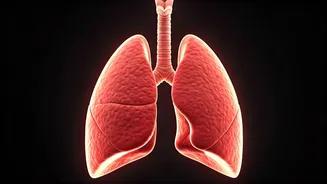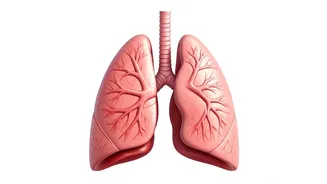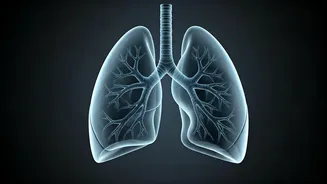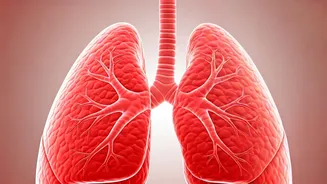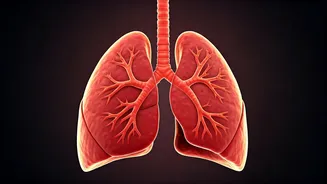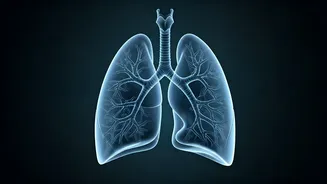Yoga and Lungs
Yoga, a practice rooted in ancient traditions, offers profound benefits, especially for the respiratory system. In today's context, where air quality fluctuates,
particularly during Diwali, the importance of healthy lungs cannot be overstated. A consistent 10-minute yoga routine can work wonders in fortifying your respiratory system. Yoga focuses on controlled breathing exercises (pranayama) and postures (asanas) that directly affect lung capacity and function. These practices increase the intake of oxygen while removing carbon dioxide, promoting improved respiratory health and making the lungs more efficient. Moreover, yoga helps clear the airways, reducing congestion that can often be associated with seasonal changes and environmental factors during the festive period. This is an accessible and practical approach to integrating wellness into the celebrations.
Pranayama Techniques
Pranayama, or breathing exercises, forms a fundamental component of yoga, and is especially beneficial for lung health. Several pranayama techniques are highly effective in enhancing lung capacity and oxygen intake, making them very useful, particularly in the lead up to Diwali. One prominent technique is 'Anulom Vilom,' or alternate nostril breathing. In this practice, you gently close one nostril and inhale deeply through the other, then switch and exhale. Repeating this rhythmic process clears nasal passages, helps to balance the nervous system, and supports efficient oxygen exchange in the lungs. Another technique is 'Kapalbhati,' or skull shining breath, that involves forceful exhalations followed by passive inhalations. This can strengthen the abdominal muscles, and effectively helps in cleansing the respiratory system. Incorporating these techniques into your daily routine is a simple yet impactful way to prepare your lungs, and protect them during the festive season.
Asanas for Airways
Besides breathing exercises, specific yoga asanas are excellent in promoting lung health. These postures are designed to expand the chest, enhance oxygen flow, and strengthen the respiratory muscles. 'Tadasana,' or mountain pose, is a foundational pose, that can be a starting point. It helps in developing an awareness of the breath and body alignment, which is the cornerstone for further poses. 'Bhujangasana,' or cobra pose, is an effective posture, involving arching the back while keeping the chest open. This stretches the chest muscles, thereby increasing lung capacity. 'Ustrasana,' or camel pose, is another useful pose that opens the chest cavity and can help in improving lung function by stretching the abdominal muscles. Regularly performing these asanas, combined with pranayama, will create a synergistic effect, strengthening the lungs and improving overall respiratory health. These should be practiced under supervision or with guidance, especially if you are a beginner.
Diwali Air Quality
The air quality during Diwali can pose challenges to respiratory health, making it an ideal time to prioritize lung care. Fireworks, festive celebrations and other activities can lead to increased levels of pollutants in the air. This can exacerbate respiratory issues, causing or worsening symptoms for individuals with existing conditions. Implementing the 10-minute yoga routine can mitigate some of the negative effects of the environment during this time. Regular yoga practice can strengthen the lungs, helping them to filter air pollutants more effectively. Furthermore, the mindfulness encouraged by yoga reduces stress, which also has a positive effect on the respiratory system. This practice provides a proactive strategy in protecting respiratory health during Diwali, allowing you to enjoy the festivities without compromising well-being.
Creating a Routine
Starting a 10-minute daily yoga routine is simple, accessible, and highly beneficial, especially when preparing for Diwali. Begin by choosing a quiet space where you can focus without disturbances. Start by warming up with gentle stretches for a few minutes to prepare your body. Next, incorporate a mix of pranayama techniques and a few key asanas. Focus on breathing deeply and mindfully throughout each exercise. Consistency is key, so try practicing at the same time each day to make it a habit. If you are new to yoga, consider using guided videos to help you understand the correct techniques. You can also customize your routine based on your experience and needs. This small investment of time can have a big impact on your lung health and your overall wellbeing, especially during a season filled with celebrations.
Mindfulness & Breathing
Integrating mindfulness and conscious breathing techniques into your daily yoga practice will amplify its benefits. Mindfulness encourages being present and aware of your body and breath. During yoga, pay attention to the sensation of each breath, as it enters and leaves your body. This conscious awareness can help you to relax, calm the nervous system, and improve the efficiency of your lungs. Breathing exercises such as 'Ujjayi' breath, or victorious breath, involve creating a slight constriction at the back of the throat during both inhalation and exhalation. This creates a gentle sound, similar to the ocean, that lengthens the breath and promotes relaxation. By combining mindfulness and focused breathing, you can increase your lung capacity and reduce the impact of stress, ultimately making this exercise a wholesome practice that benefits both your body and mind.
Additional Tips
To maximize the advantages of your 10-minute yoga practice, and maintain good respiratory health, consider these additional tips. Stay hydrated by drinking plenty of water throughout the day. This keeps your respiratory passages lubricated, promoting better breathing. Maintain a healthy diet rich in nutrients and antioxidants to support your immune system and overall health. If you are in an area with poor air quality, consider using an air purifier, especially during the festive season when pollution levels are often higher. If you have any underlying respiratory conditions, it is crucial to consult your doctor before starting any new exercise routine. Adjust your routine as needed, listening to your body and respecting its limits. Combining these practical tips with your daily yoga practice creates a more comprehensive strategy for maintaining robust lung health and a balanced lifestyle.
